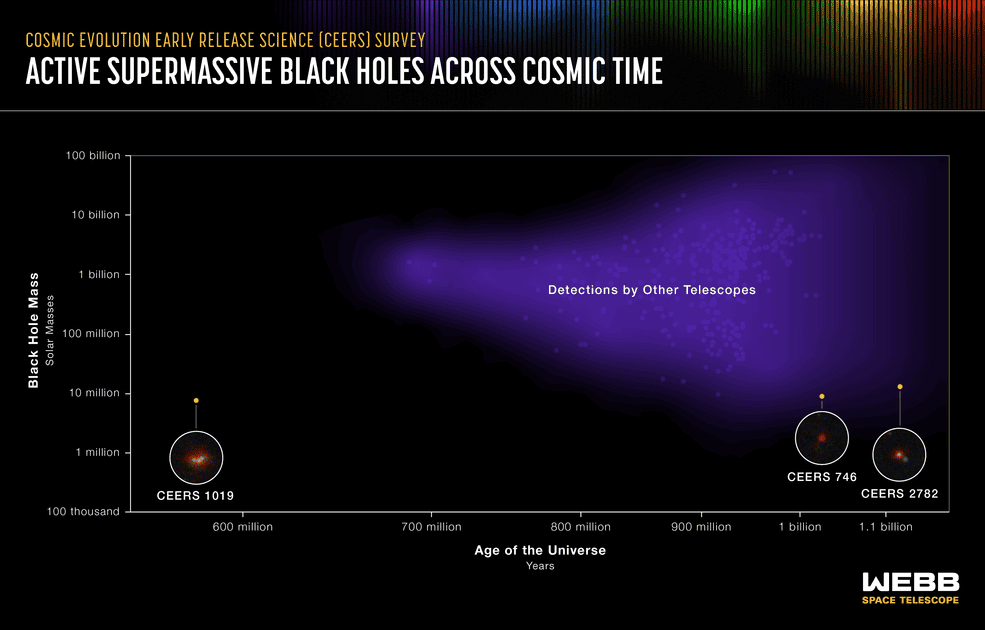The James Webb Space Telescope (JWST) has identified the most distant active supermassive black hole to date. Its host galaxy, known as CEERS 1019, existed a mere 570 million years after the Big Bang. What sets this ancient galaxy apart is the relatively small size of its black hole compared to others detected in the early universe.
Webb’s Cosmic Evolution Early Release Science (CEERS) Survey, led by Steven Finkelstein of the University of Texas at Austin, provided the evidence for these remarkable findings.
“Until now, research about objects in the early universe was largely theoretical,” Finkelstein said. “With Webb, not only can we see black holes and galaxies at extreme distances, we can now start to accurately measure them. That’s the tremendous power of this telescope.”
Ancient but tiny by supermassive standards
CEERS 1019 is notable for its ancient existence and the relatively light mass of its black hole, which is approximately nine million times the mass of our Sun. This is significantly less massive than other early universe black holes detected using different telescopes.
Typically, these behemoth black holes contain over a billion solar masses and are easier to detect due to their brightness resulting from consumed matter. In contrast, the black hole in CEERS 1019 is more comparable in size to the one at the center of our Milky Way galaxy, which is about 4.6 million times the mass of the Sun.
However, this black hole is still challenging to explain despite its smaller size given its early formation. The existence of smaller black holes in the early universe has been theorized for some time, but Webb’s observations have now provided definitive evidence. It is worth noting that other claims of even more distant black holes identified by the JWST are currently undergoing rigorous review by the astronomical community.
CEERS team member Rebecca Larson of the University of Texas at Austin emphasized the wealth of spectral lines available for analysis, making the observations similar to those of black holes in galaxies near our own. A spectral line is part of a light spectrum that is either weaker or stronger than the rest. This is caused by the emission or absorption of light in a small frequency range compared to the frequencies close by. Spectral lines are often used to identify atoms and molecules.
“Looking at this distant object with this telescope is a lot like looking at data from black holes that exist in galaxies near our own,” Larson, who led this discovery, said. “There are so many spectral lines to analyze!”
The researchers also examined the visual characteristics of CEERS 1019 and found that it appeared as three bright clumps rather than a single circular disk. This peculiar structure led them to speculate that a galaxy merger may be responsible for fueling the activity in the black hole, which, in turn, could lead to increased star formation.
In addition to CEERS 1019, the CEERS Survey team identified two more small black holes. The first, located within galaxy CEERS 2782, was easily distinguishable as no dust obstructed Webb’s view. Its existence dates back to only 1.1 billion years after the Big Bang. The second black hole, in galaxy CEERS 746, emerged slightly earlier, around one billion years after the Big Bang. Although partially obscured by dust, its bright accretion disk indicates that the galaxy is also experiencing intense star formation.

These two black holes, like the one in CEERS 1019, are considered “lightweights” compared to previously known supermassive black holes at similar distances. They are approximately 10 million times the mass of the Sun.
Team member Dale Kocevski of Colby College noted that lower-mass black holes may be more abundant in the early universe than previously thought.
“The central black hole is visible, but the presence of dust suggests it might lie within a galaxy that is also furiously pumping out stars,” Kocevski said. “Researchers have long known that there must be lower mass black holes in the early universe. Now we think that lower mass black holes might be all over the place, waiting to be discovered.”
The JWST’s sensitive spectra also provided precise measurements of the distances and galaxy ages in the early universe. The researchers identified 11 galaxies between 470 and 675 million years after the Big Bang. Despite being extremely distant, these galaxies are undergoing rapid star formation and are less chemically enriched than closer galaxies.
In the future, the JWST’s data may also be used to explain how early black holes formed, revising researchers’ models of how black holes grew and evolved in the first several hundred million years of the universe’s history.







